
Water Quality in the Western Lake Michigan Drainages, Wisconsin and Michigan, 1992-95
Table of contents || Previous section || Next section || Glossary
SUMMARY OF MAJOR ISSUES AND FINDINGS
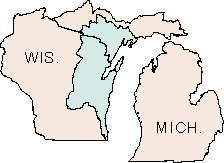
LEVELS OF SOME NATURALLY OCCURRING CHEMICALS HAVE THE POTENTIAL TO AFFECT HUMAN HEALTH AND AQUATIC LIFE. Part A
Concentrations of naturally occurring constituents are variable in surface water and ground water of the study area. At some sites the concentrations exceed those considered harmful to human health and aquatic life.
- Dissolved solids concentrations above the United States Environmental Protection Agency's (USEPA) secondary maximum contaminant levels (SMCL) for drinking water were detected in 26 percent of samples from the confined part of the drinking-water aquifer.
- Arsenic concentrations in fine sediments in streams exceeded the Ontario Ministry of Environment and Energy lowest effect level (LEL), for aquatic biota, at 48 percent of sites sampled and the severe effect level (SEL) at one site.
- Radon, a carcinogen, was detected in all 29 drinking-water aquifer wells sampled in the study area. Radon activities in 66 percent of the wells exceeded the previously proposed USEPA standard of 300 picocuries per liter (pCi/L).
- Concentrations of dissolved iron exceeded the previously proposed USEPA maximum contaminant level (MCL) for drinking water of 300 micrograms per liter (µg/L) in 38 percent of drinking-water aquifer wells sampled.
|
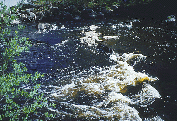 (126,352 bytes) (126,352 bytes)
|
FERTILIZERS AND LIVESTOCK WASTES INCREASE NUTRIENT CONCENTRATIONS IN STREAMS AND GROUND WATER. Part B
Phosphorus and nitrate concentrations in surface water and ground water are highest in agricultural land-use areas. Nutrient concentrations in surface waters were highest during periods of precipitation runoff.
- Ninety-six percent of anthropogenic phosphorus input to the study area is from fertilizer and livestock wastes.
- Median phosphorus concentrations in surface water at four agricultural study sites exceeded the recommended USEPA limit to discourage excessive biotic growth in flowing water of 0.1 milligrams per liter (mg/L).
- Analysis of historical data indicated that phosphorus concentrations in surface water downstream from urban areas decreased significantly during the 1970s due to the reduction of phosphorus in detergents and improvements in sewage-treatment facilities.
- Nitrate concentrations in surface water from 92 percent of samples from agricultural Indicator Sites were high enough to contribute to algal blooms (greater than 0.3 mg/L) observed at several sites.
- Nitrate concentrations exceeded the USEPA MCL (10 mg/L) during three storms at the East River agricultural Indicator Site, in 9 percent of the samples from the drinking water aquifer, and 22 percent of the surficial alluvial aquifer samples.
- Nitrate concentrations, in the shallow alluvial aquifer where the surficial deposits were most permeable, exceeded the USEPA MCL in 37 percent of the samples.
|
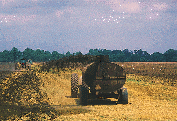 (96,843 bytes) (96,843 bytes)
|
VARIOUS FACTORS CONTROL PESTICIDE OCCURRENCE IN STREAMS AND GROUND WATER. Part C
Fifteen pesticides were detected in ground water and 33 in surface water. Drinking water standards for atrazine were exceeded in 6 percent of surface-water samples and standards for simazine and alachlor were exceeded in 1 percent of the samples.
- Pesticides commonly applied to farm fields were typically detected in surface water in intensively farmed areas at concentrations 100 times higher than in less intensively farmed areas.
- Atrazine was detected in all 143 surface water samples collected, including some at very low concentrations (0.005 mg/L) from forested areas. Detection in forested areas is probably due to the presence of pesticides in precipitation in the area.
- Highest concentrations of pesticides in surface water occur during runoff in agricultural areas soon after pesticide applications to the farm fields.
- Pesticides were detected in 97 percent of samples from surficial aquifers in intensively farmed areas underlain by relatively permeable surficial deposits. Concentrations of atrazine plus deethylatrazine exceeded the State of Wisconsin's preventive action limit of 0.3 mg/L in 22 percent of surficial aquifer wells.
- Pesticides were detected in 25 percent of drinking water aquifer wells sampled. Eighty-six percent of these detections were in samples from wells in the part of the aquifer not covered by the relatively impermeable Sinnipee unit.
|
 (113,976 bytes) (113,976 bytes)
|
URBAN AREAS ARE A SOURCE OF TRACE ELEMENTS AND ORGANIC COMPOUNDS. Part D
Concentrations of cadmium, copper, mercury, nickel, lead, and zinc and of many toxic synthetic organic compounds were highest in fine sediments in streams that drained urban areas compared to other land uses.
- Concentrations of PCBs in streambed sediments and fish tissue are 10 times higher in large-river sites draining urban areas than in smaller urban, agricultural, or forested land-use areas.
- Concentrations of DDT remain high in streambed sediments in urban areas and large-river sites more than 20 years after being banned.
- Eight trace elements in fine streambed sediment exceeded established LEL for bulk sediment. The chromium LEL was exceeded in all
42 samples collected. The LEL is the concentration that 95 percent of benthic biota can tolerate.
- Eighty percent of semivolatile organic compounds (SVOCs) analyzed for were detected in at least one sample. Two classes of SVOCs (PAHs and phthalates) were detected more frequently and in higher concentrations at urban-affected sites.
|
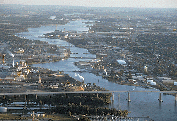 (92,687 bytes) (92,687 bytes)
|
ENVIRONMENTAL SETTING AND LAND USE INFLUENCE AQUATIC LIFE. Part E
Water quality, as indicated by aquatic life, was most influenced by land use and type of surficial deposit.
- Aquatic life was most degraded in urban areas and least degraded in forested areas.
- Indexes of biotic integrity indicated degraded water quality at sites with clay surficial deposits.
- Water quality in streams in primarily agricultural areas was least degraded in the basins with the highest percentage of forested land use.
- In general, there was good agreement between biological indicator scores calculated for habitat, algae, benthic invertebrates, and fish.
|
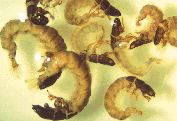 (61,051 bytes) (61,051 bytes)
|
U.S. Geological Survey Circular 1156
Table of contents || Previous section || Next section || Glossary
Suggested citation:
C. A. Peters, D. M. Robertson, D. A. Saad, D. J. Sullivan, B. C. Scudder, F. A. Fitzpatrick, K. D. Richards, J. S. Stewart, S. A. Fitzgerald, and B. N. Lenz, 1998, U.S. Geological Survey Circular 1156, on line at <URL: https://water.usgs.gov/pubs/circ1156>, updated June 11, 1998
